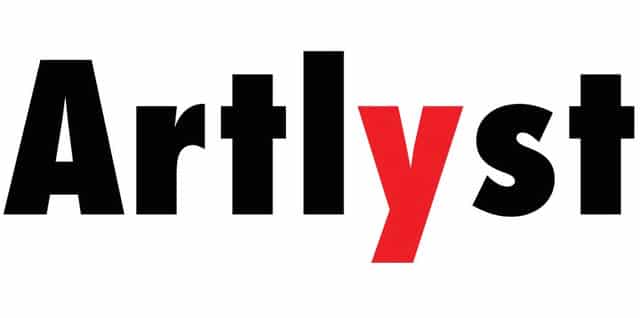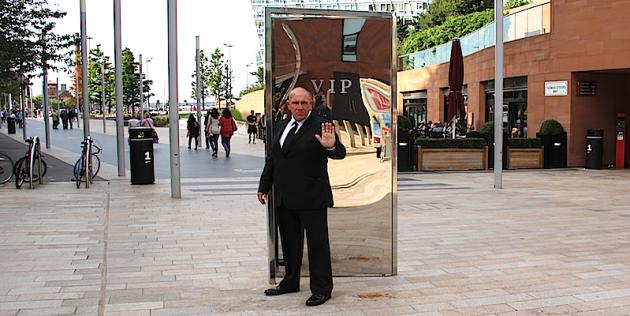It’s difficult to know where to begin when discussing a show that includes 242 artists in 27 locations. Liverpool has given itself over to contemporary art for the next 10 weeks, exploring the theme of ‘hospitality’. Within that realm there is a sub-themed exhibition, ‘The Unexpected Guest’ curated by Lorenzo Fusi, in which works by over 60 international artists are revealed across the city. Red signs are posted all over a grand, spruced up Liverpool directing you to locations around the city. Most exhibits are within buildings: some are already dedicated art venues such as the Tate, The Walker Art Gallery, the Bluecoat and the sparkling,new Open Eye while others have been hijacked for exhibition spaces such as the diametrically opposed bleak, warehouse space of the former Royal Mail Sorting Office on Copperas Street and the elegant marble and ironwork heavy Cunard building.
The most exciting works are those that you stumble across in public spaces especially those in the Liverpool One shopping district. Oded Hirsch’s The Lift literally bursts out of the pavement in the middle of the pedestrianized streets suggesting something mysterious in the earth beneath while Elmsgreen & Dragset’s brilliant ‘But I’m on the Guest List too!’ – a performance piece in which a bouncer prevents anyone that asks from entering a free standing, slightly ajar silver door with the words VIP written on it, thereby challenging the hierarchy of values established by celebrity culture.
The impressive Cunard building, situated on the waterfront is one of the city’s famous ‘Three Graces’ between the Port of Liverpool Building and the Royal Liver Building, is opened to the public for the first time for the biennial. It is home to an impressive exhibition of international artists following the unexpected guest theme. Meticulously painted estate agent ‘To Let’ signs are displayed as banners by Superflex a statement alluding to the abundance of empty office and commercial spaces in Liverpool’s financial district. While wandering around the city you can’t help but feel that it is a point very well made by this group of artists from Denmark. French artist Sylvie Blocher displays films of utopian political speeches, which are hung like banners changing to decorative backgrounds in between segments. I particularly liked Nadia Kaabi-Linke’s video installation about the visa process. A church style congregation chants answers to questions printed on the UK’s standard visa form from a screen of moving lips facing the screen of the church. Of particular note also is Mikhael Subotsky and Patrick Waterhouse’s archaeological study of the cylindrical Ponte building in Johannesburg, a symbol for social and economic downturn. It is a photographic journey through the building filming each floor in turn.

The Bluecoat Gallery hosts an equally impressive exhibition on the same subject. The courtyard has Dan Graham’s pavilion 2-way Mirror Cylinder Bisected by Perforated Stainless Steel a playful piece exploring the notion of simultaneously watching oneself and others. Inside Sun Xun explores the cultural traditions of Hospitality in his native China with a large-scale installation of drawing and animation of waves based on Son Dynasty customs and style from the 11th century.
The Open Eye Gallery, one of the UK’s leading photography spaces, moved to its brand new purpose-built site on the waterfront near the Tate only last November. The main exhibition features the twin projects Love Hotel and The Park by Japanese photographer Kohei Yoshiyuki. Love Hotel 1978 captures frozen images from sex tapes made by the clients of an infamous Tokyo book-by-the-hour hotel. The blurred stills are explicit but barely legible. If this doesn’t make you feel dirty, the main exhibit titled, ‘The Park’ involves the viewer by giving them a torch before entering a darkened room. The photos are taken of straight and Gay couples engaged in sexual activity while Peeping Toms stalk them. You can only see the photos by holding the torch up to them, which adds to the dark voyeuristic experience. It also features the work of US artist Mark Morrisroe who produced photograms of his body alongside cuttings from pornographic magazines and other objects, while dying from an AIDS related illness in a Boston hospital. Many of the images were produced in his ward bathroom.
If this isn’t enough for your ‘Art Fix,’ Tate Liverpool features the seminal video artist Doug Aitken’s first public installation in the UK entitled ‘The Source’. It features filmed conversations with some of the world’s most creative individuals working across different art forms, exploring the roots of the creative process. It is housed in a temporary pavilion designed by Aitken in collaboration with British architect David Adjaye OBE. The filmed conversations are shown on six screens within the pavilion during gallery opening hours and projected outwards from the structure after dark. The 18 subjects include Beck, Jack White, Tilda Swinton, Jacques Herzog and Richard Phillips and the conversations have been edited down to 4 minutes each. On entering the chaotic scene the viewer is invited to dip into each conversation, thereby editing his or her own film and breaking the passive feel of cinema. Unfortunately, I didn’t get to see it projected on the outside at night, which I am sure would have made the experience even more impressive.

This year’s John Moores Painting Prize and accompanying exhibition is at the Walker Art Gallery but with everything else to take in from the biennial it was hard to summon up much emotion. Sarah Pickstone won for her large yellow washed painting ‘Stevie Smith and the Willow’ but special mention must go to Narbi Price’s Untitled Kerbstone painting.

Similarly The Bloomberg New Contemporaries was swamped by the cavernous space at the LJMU Copperhas Hill building with very little standing out except maybe Lauren Godfrey’s take on Memphis furniture in the form of a rubber stamp and impression on the wall next to it. Perhaps this exhibition will need to be re-evaluated when it comes to the ICA in London later this year.

The City States exhibition upstairs in the same building was also underwhelming. Thirteen different cities curated their own show in response to the theme of hospitality. Only Hong Kong stood out with its installation of 6 videos of different cities hung irregularly in zig zags which mimicked walking down a road. Vilnius did try to fill the space with its enormous black inflatable pillow but why I’m not sure. The Korean embroidered Morris Louis canvases were also perplexing. Go and see the originals in Boston, a much better visual experience, without the gimmick.

Several satellite exhibitions are on show during the ten week run of this art extravaganza. Some of the smaller events elsewhere are also worth a look- in. I was unable to see them all in such a short space of time. However, I did enjoy the Monro’s Markus Kahre’s room located above a busy pub. The installation led you to a series of rooms with spooky mirrors that revealed a hidden chamber instead of your own reflection. Particular mention must also go to a show at ‘The Gallery’ in Stanhope Street of the underrated Post Modern painter Duggie Fields. It included a mini survey of his canvases along with small furniture and new cut-outs of his iconic imagery, mounted on plastic. Duggie is perhaps the missing link between Patrick Caulfield and Julian Opie and someone who desperately deserves a re-evaluation of his undervalued body of work from the 1970’s to present. Andrew Logan, Zandra Rhodes and Caroline Coons were there as well to cheer him on! Magic! It should also be noted that Liverpool knows how to throw a good after party, as well. Everyone was just getting going at 2:00am in a disused knife factory called Camp and Furnace, thousands attended, all in good sprits.

Hopping back on the train for London I put my feet up and reflected on this two day trip of art and activity. The first thing that was clear was that London is not the be all and end all for culture and for at least the next few weeks the North West will rock with culture and innovation. The second thing that was obvious was that this was a world class biennial and under the directorship of Sally Tallant it has come a long way since its inception. I suspect at this rate of growth the Liverpool Biennial will give the older established international exhibitions a run for their money in the future.
Words: Sara Faith / Photos: P C Robinson © ArtLyst 2012


